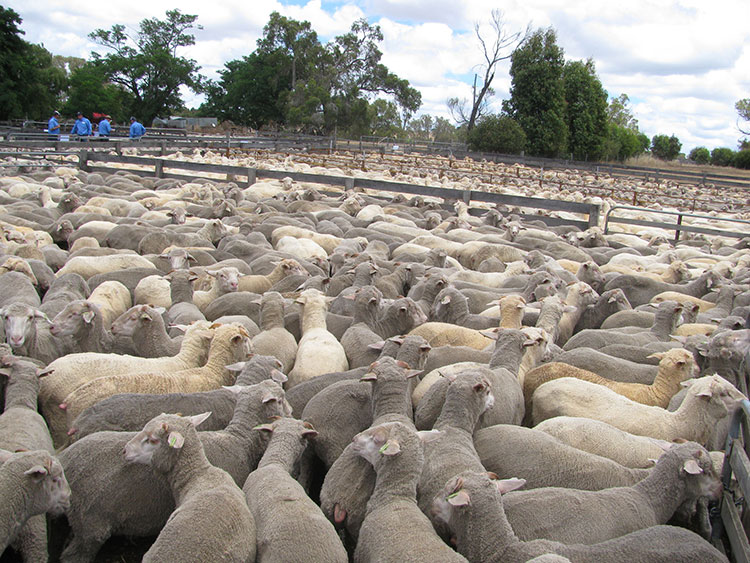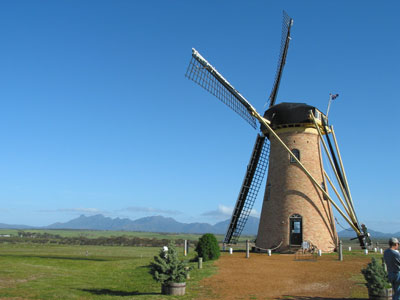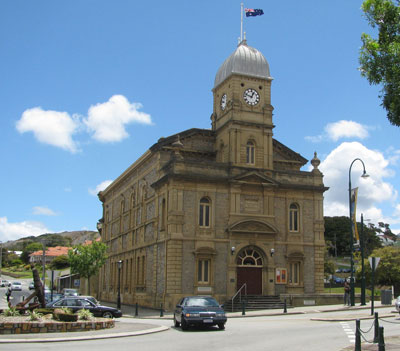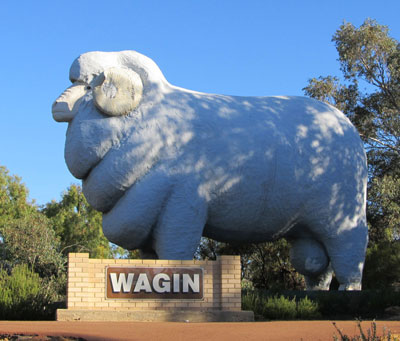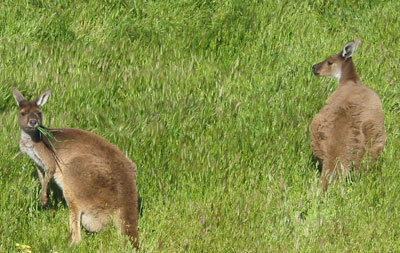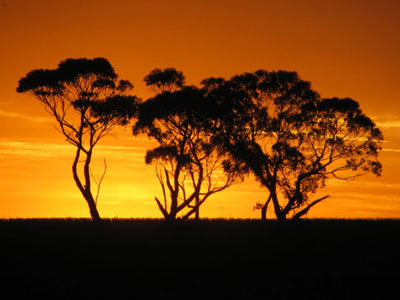Wine, windmills and white sand — discovering Western Australia on a coastal road trip
This article appears on page 36 of the November 2013 issue.
by Inga Aksamit; Kenwood, CA
The Great Southern region of Australia, located along the south coast of Western Australia, is an area that most American visitors to this continent never get to. A patchwork of bush, sheep ranches and farmland provides endless pastoral vistas in a sparsely populated, but hardly empty, landscape before abruptly smacking into the desolate Outback.
In 2012, that landscape had gotten under our skin (and nails) when my husband, Steve, and I spent two months on a different kind of holiday, bringing in the harvest of winter wheat, barley, canola and lupine at Caralinga Farms, Philip and Kelli O’Meehan’s 13,000-acre farm near Borden, Western Australia. Steve got to live his dream of being a farmhand while I helped my friend Kelli support the effort.
It wasn’t exactly my dream to be a farm wife, but I embraced the experience as a rare opportunity to live a completely different life for a finite period of time. Having heard Kelli’s stories of adapting to the farm following our shared university days in Northern California, I was curious to see what it was like.
Twelve- to 18-hour days saw Steve battling schizophrenic weather, giant machines that could take an arm off in an instant and a precipitous learning curve while I adapted to 90-minute journeys to the supermarket (don’t forget the milk!), unceasing casserole assembly and a constant battle with gritty red dust.
The routine didn’t give us much time for exploration, so when we returned in March 2013 for a wedding, we looked forward to seeing more of the surrounding area.
Returning for more
This time we found some unusual entities rising up from the level terrain — from windmills to statues of historical figures and giant rams — and discovered bountiful wine regions and a rugged coast punctuated by long stretches of sandy beaches. We took a meandering route so we could see as much as possible. (You can find a map of our road trip at http://goo.gl/maps/xjwqb.)
In Perth we had a day to recover from the long international flight that took us there from California. We strolled along miles of seaside tracks at Cottesloe and Scarborough beaches, with their acres of clean, white sand, and explored some neighborhood restaurants that reminded us a lot of home. (The foodie revolution is everywhere!)
A couple of our favorite casual eateries were The Wild Fig (190 The Esplanade, Scarborough; phone 08 9245 5222), a hip and eclectic café near the waterfront that served such delicacies as pork belly, blue swimmer crab and beetroot-infused carpaccio (entrées $20-$30), and Little Creatures Brewery (40 Mews Rd., Fremantle; phone 08 9430 5555), a popular brewpub, which started in an old crocodile farm, that has a wonderful outdoor deck serving thin-crust pizza and kangaroo with tomato chutney (entrées, $9-$25).
Heading south the next day on Highway 2, we embarked on a 130-mile lackluster drive, the highway being back just far enough from the coast to eliminate what might have been tantalizing ocean views. We kept a sharp eye out for highway hazards, as it’s not uncommon to see kangaroos hopping through the fields in that area.
Wine country
The Great Southern is famous for the top-notch wines that come from the Margaret River region, but we wanted to explore a lesser-known area. We settled on Donnybrook, a pleasant agricultural town in the Geographe wine region that also celebrates another major crop, apples.
The street lamps were shaped like large apples, and the annual Apple Festival was just gearing up as we passed through.
We looked for some fast food but, luckily for us, happened upon the Apple Tree Inn (58 South Western Hwy.) instead, which turned out a delicious Asian beef salad full of authentic bright flavors and crisp, fresh vegetables. The delicately battered fish and chips were cooked perfectly, each crunchy bite giving way to tender, succulent fish just like you’d find in London (about AUD13, or $12, per person).
After stopping at the Donnybrook Visitor Center for some winery advice, we headed off to Barrecas Winery (19001 South Western Hwy., Donnybrook; phone 9731 1716). We quickly discovered that many of the area wineries were smaller, less formal operations than those found at home in Sonoma County.
Driving up to a ranch-style house and assuming we had made a wrong turn, we started backing up when a woman dashed out of the house and pointed to the barn in back. There we found a tiny tasting room with large windows overlooking a nearby olive orchard, where a hundred head of cattle grazed contentedly. It was obvious that the Barreca farm was diversified.
Owner Kelly Barreca was astonished that we were visiting her vineyard all the way from California, and we were astounded at how polished the wines were, with the Barbera and Shiraz being our favorites.
There was a steady stream of people through the tasting room picking up wine, and we went out with a case of the Barbera for the wedding at an unbelievably low price of AUD90 ($83) for the 12 bottles (with a half-off sale).
The next winery, Smallwater Estate (52 Tramline Rd., Donnybrook; phone 08 9731 6036), was down a bumpy dirt road bordering a wooded preserve. Once we found the tasting room, the scene was like a postcard, with sweeping views of vineyards, farmland and a pond at the bottom of a swale. This winery was enhanced by its restaurant overlooking the pond, adjacent to the tasting room.
Though this was a more developed operation than Barrecas’, we had the place to ourselves and particularly enjoyed the ubiquitous Shiraz, as well as the Zinfandel rosé, while chatting with proprietor Gail Byrne.
Kojonup
Pressing on, we stopped in Kojonup later that afternoon, visiting Kodja Place and the Pioneer Museum to learn about some of the history of the region.
The local Noongar tribe arrived long before any Europeans, settling in this fertile area 45,000 years ago, no doubt attracted to the many creeks and springs found in the region. Countless Noongar place names end with “up,” the aboriginal term for “place of.”
Kojonup was named for the place of kodja, the stone axes that once were crafted there. European pioneers arrived in the early 1800s to raise sheep, harvest sandalwood and hunt kangaroos, plentiful in the area.
Kojonup claims a piece of Australian military history involving the famed Kokoda Track campaign. In World War II, a brutal confrontation between Japanese and Allied soldiers, primarily Australian, occurred in the inhospitable, tropical environment of present-day Papua New Guinea, an island just 100 miles north of Australia. Brigadier Arnold Potts, who lived in Kojonup, played a key role in leading the Australian troops.
The A.W. Potts Kokoda Track Memorial Statue was erected at Kojonup’s Apex Park (located at the corner of the Albany Highway and Broomehill Road) in 2007. Many Australians still participate in a pilgrimage to replicate the historic hike, albeit with porters and modern conveniences, but it remains an arduous journey, traversing 60 humid miles with many gains and losses of elevation.
Albany
Though it had been a long day, we pushed on to Albany after sundown, arriving in the attractive, mid-size deepwater port town that got its start as a whaling center and gateway to the goldfields around Esperance.
The weather there can be finicky, but during our stay we enjoyed balmy summer temperatures that enticed us to the beach every day. We enjoyed strolling along the waterfront and exploring downtown York Street, lined with public art, local shops and eateries — a nice change from anonymous-looking shopping centers.
We particularly relished the Mean Fiddler (132 York St.; phone 08 9841 1852), where we delved into grilled barramundi, delectable, crispy pork belly and a salad of mixed greens, sweet cherry tomatoes and crunchy cucumbers, a simple treat that was sometimes hard to find in Western Australia. Entrées cost $15-$25. The assorted dessert plate was fun, with bites of cookies, tarts, chocolate and fruit.
We stayed in Emu Point at Albany Bayside Ocean Villas (phone +61 400 216 971), a pair of identical houses that looked more like a residential subdivision than holiday villas (AUD365 per night). Once inside, however, we found the 3-bedroom dwellings to be roomy, airy and comfortable for our group of three couples, all attending the wedding; these would be perfect for a family holiday.
The kitchen was well stocked, and we took pleasure in barbecuing on the patio with friends.
A few steps away was a walking path to Middleton Beach, where we strolled every morning, squishing the fine, white sand between our toes while basking in the warmth of a summer day.
Bluff Knoll
After the wedding festivities, we continued on our road trip, filling up the gas tank before we left, mindful that a lot of small towns in these rural farming regions don’t have gas stations as the farms all have their own fuel depots.
Driving north from Albany on Chester Pass Road, we watched the spikes of the Stirling Range rise up like the spine of an iguana from the pancake-flat farmland.
We couldn’t resist a vigorous hike to the top of 3,600-foot-high Bluff Knoll, following the steep, rocky trail dotted with grass trees (Xanthorrhoea), a plant native to this area. An extremely slow-growing tree, it could take 10 years to form the short, stout trunk that sprouts a grass-like fringe, resembling hair, from the top.
The oldest specimens there may have been growing for 600 years, and its dark wood is prized by collectors who value the attractive bowls, vases and other objects that can be carved from it.
The 360-degree view was worth the 3.7-mile hike, the checkerboard pattern of farms and ranches stretching north to the distant outback and south toward the blue expanse of the Southern Ocean.
Unique accommodation
A highlight of our trip was a stay at The Lily (phone +61 8 9827 9205), a unique, European-style B&B located between Borden and Albany and owned and operated by a Dutch couple. Pleun and Hennie Hitzert brought some of their homeland to Australia, lovingly handcrafting an authentic, full-scale windmill to grind the spelt, an ancient grain that dates back 7,000 years, that they grow on their land.
The sails dominate the homestead, extending a whopping 80 feet.
We stayed in one of two traditional Dutch brick cottages ($139-$169 per night), also built by the Hitzerts, and enjoyed the cozy wood stove and Hennie’s treasures that she has collected from around the world.
Hennie’s wonderful European-style home cooking is normally featured at their adjacent restaurant, but since it was closed for the night, she brought a complete dinner in a large hamper to the cottage ($100 for two).
We started with a rich gratin of witlof (Belgian endive wrapped in ham and smothered in a creamy cheese sauce), then feasted on tender, locally raised Butterfield beef, crisply roasted potatoes, sweet, steamed carrots and fresh broccolini.
A basket of breakfast foods, including home-baked spelt bread, farm-fresh eggs, chilled orange juice, muesli, yogurt and milk, provided all the ingredients for a complete do-it-yourself breakfast the next morning.
Borden and Ongerup
The next day we pulled away from the windmill and Stirling Range to settle in for the long return drive to Perth, passing through a series of small farming communities. We spotted kangaroos, emus and wallabies bounding through the fields, delighting us even though we knew they wreaked havoc on the crops as they munched their way down the neat rows of grain. (They also cause problems with vehicles, as they come raining from the sky to strike a hapless windshield despite the ubiquitous ’roo bars affixed to cars.)
Making a brief stop at the pub in Borden (population 164), we chatted with some of the local farmers we had met during our stay the previous year and caught up on all the local crop news.
After Borden, we took a short detour, turning east on the Gnowangerup-Jerramungup Road to visit the village of Ongerup to see the endangered malleefowl, a large, chicken-like bird.
The Yongergnow Australian Malleefowl Centre (Lot 260 Jaekel St.) is a small, state-of-the-art community center, café, museum and wildlife refuge dedicated to saving these animals. We were able to see two live malleefowls, almost perfectly camouflaged against the leafy foliage in a spacious fenced area.
Equally as interesting to me, though the locals seemed completely indifferent, was a section of the historic rabbit-proof fence that once spanned 2,000 miles across the Outback — a futile attempt to block the inexorable advance of the introduced pests. Snippets of the fence can be seen in various places, but this was the only section I saw during our visits.
Backtracking to Gnowangerup, which has shops and services but, again, no fuel, we admired an old steam tractor located in front of the Shire administration building that honors the first farmers to settle there. The Machinery Museum (on the corner of Strathaven and Yougenup roads) offers a look at the early farm contraptions that enabled those early settlers to clear the land.
Statue stops
We made a quick refueling stop in Katanning, filled with many attractive heritage buildings such as the Town Hall, the King George Hostel, Kobeelya and the Old Roller Flour Mill.
The railway carriages near the Albion Street intersection are a reminder of the importance of the Great Southern Railway to the development of Katanning and the surrounding area. A statue of Frederick Piesse, one of the town’s founders, sits in front of the station.
There was one attraction that I had to see again, so we made sure to allow extra time to see the Wagin mascot, a giant ram statue that stands 20 feet high and 43 feet long, located in the Wetlands Park on Arthur River Road. It’s one of those sights that is humorous yet strangely beguiling, and we circled the ram several times, chuckling over the city leaders who dreamed this up.
A more serious display, the nearby Wagin Historical Village offers a comprehensive collection of fully restored and replica rural buildings, machinery and equipment that provides an agreeable way to spend an hour. It is open seven days a week, year-round (10 a.m. to 4 p.m.).
Back to Perth
As the miles fell away, we saw large ranches running robust, healthy sheep and cattle, along with vast tracts of land shimmering with waving grain and vineyards heavy with grapes — a truly bountiful land.
When we neared the outskirts of Perth, we passed many preserves and parks that form a contiguous band of protected land with inviting trailheads leading into the bush, where you can lose yourself for hours, days or weeks.
Large groves of grass trees were visible in these preserves, along with another tree native to southwest Australia, the most common species of eucalyptus, referred to locally by its Aboriginal name, jarrah. A tall, leafy tree that can reach a height of 130 feet, the hard, straight, durable wood has many uses in building fences, bridges, telephone poles, cabinets and even musical instruments.
The Great Southern has provided the raw materials to sustain life for many generations, from the original Noongar tribes to the European descendants who farm the land today. We felt privileged to have experienced small slices of Western Australian life on our repeated visits.
The Great Southern is rich in history and has much to offer the visitor, from award-winning wineries and strenuous hikes to relaxing seaside resorts. And you just might see a sheep or two on the way.

